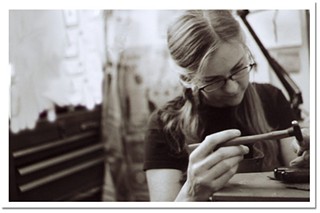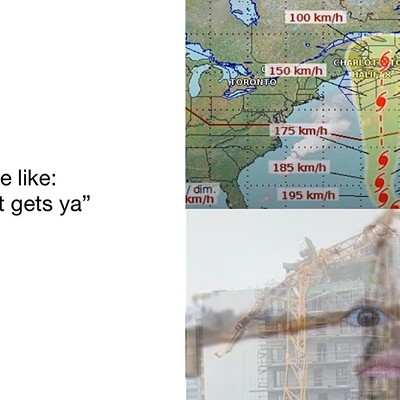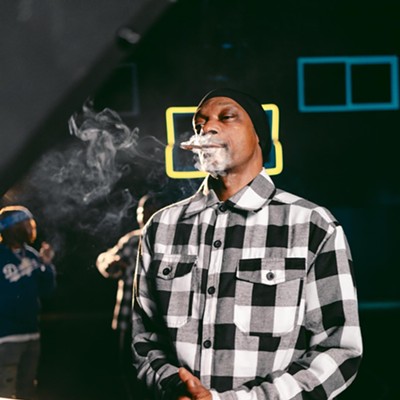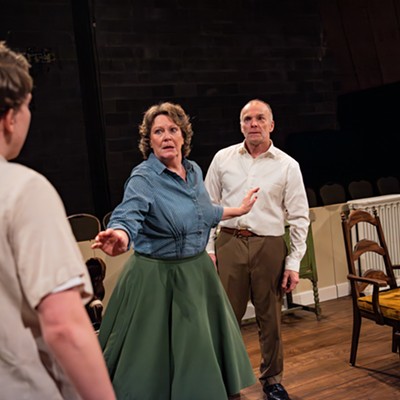People talk about making the New Year a time for resolutions. Some people actually make good on the talk. You can count Dorothée Rosen among those who follow through.
The Halifax jeweller returns after a lengthy hiatus from making and exhibiting work with a show at the Mary E. Black Gallery, called Selective Intuition. (Her last solo show in Halifax was in 2004 at Anna Leonowens Gallery.) Rosen is joined by fellow German maker Imke Jassmann. The two artists met when both were students and Jassmann was on exchange at NSCAD.
"The main reason was that I got really ill," Rosen says about the hiatus. Her illness hit about midway through 2006. She lost the rest of that year and part of the next, 2007, recovering. Rosen recalls lying in a hospital bed with "people talking over my head, "She may not make it through the night.'"
Part of her recovery was spent away from home. Last January and February she undertook a definitive physical journey. "I went on a pilgrimage to Buddhist holy sites in India," explains Rosen, a practitioner for some 17 years. According to the artist, the trip was part of a wholesale re-examination of her professional and personal life. Though she remains quiet on the latter, her new work in this show reflects the impact of the re-evaluation. "A lot of the pieces are about breaking out—breaking through."
Those familiar with Rosen's previous work—her Crush Rings and One Footers, for example—observed and were drawn in by the way she compressed, wrapped and wound metal. Though she's still wielding her hydraulic press to join materials together, there are big openings and wider spaces.
Creating the new work was "physically demanding," says Rosen. One metal—be it copper, silver and gold—was pushed through small cuts in a sheet of another, or she pierced one with another. Unlike before, when a crack occurred in these new objects it was accepted as part of the serendipity— the "surprise"—of working with the materials.
Also new to her process is the use of one-off casting. Whereas before she went directly to fabricating designs with the metal, for this work she used one-off casts, employing the lost-wax method. She made the design for an object in wax, which was burned off when cast in the metal. Rosen also used plastic casts, which required her to "move incredibly fast." Still, these were not moulds, she's careful to point out. Rosen made a cast for every piece, ensuring the unique character of each one.
During her recovery, travels abroad and closer to home, photography played an important role in Rosen's life and work. She studied contemplative photography, abstracted and colour-saturated views of the world that pivot on simple line and design. Photography didn't tax her physically the way working in her jewellery studio did. Eventually, the pictures played into the metalsmithing.
"The pendants started out with a photograph on the Cabot Trail, light shining through thick black layers of cloud and hitting the water," says Rosen. In India, she moved south in her journey, documenting some of 60 different languages and written scripts used in the country.
"The further south you get, the more ornamental the script becomes," Rosen says. She took to the fluid, calligraphic types especially. "I wanted to translate that fluidity, that kind of line, into metal," which fits in well with her overall practice: "I'm interested in moving metal." Rosen is excited to be showing with Imke Jassmann because of the contrast in their work. Ironically, "I kind of almost envy approach—it's very free. There's very little metal involved in her work," Rosen says, adding that Jassmann employs unconventional material such as "poured PVC, which becomes almost skin-like. I find them almost shocking."
Rosen and Jassmann have stayed in close touch, critiquing each other's work, in preparation for this show, despite the ocean between them. The support of a friend and colleague has been important to Rosen as she return to exhibition and a full-time practice, and she sounds thankful.
"It's very hard as an artist to find someone to give straightforward and helpful critiques."













